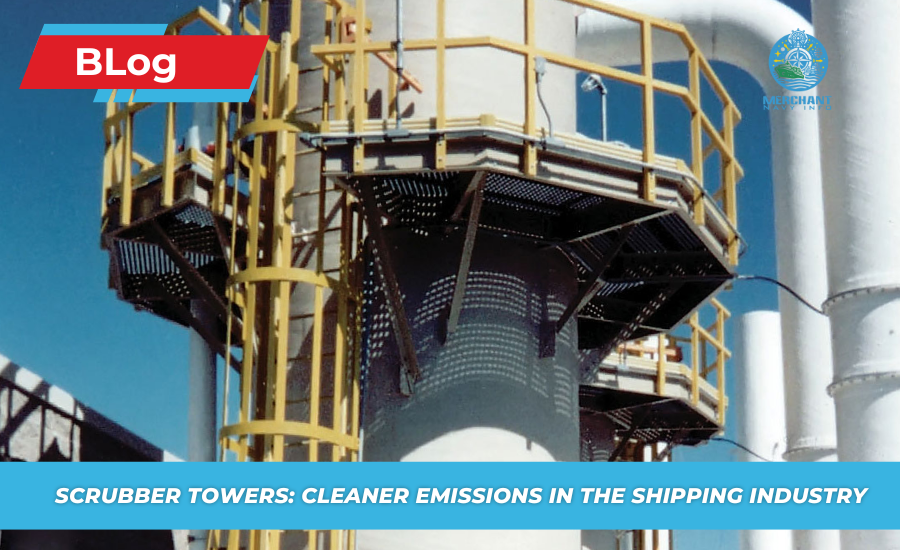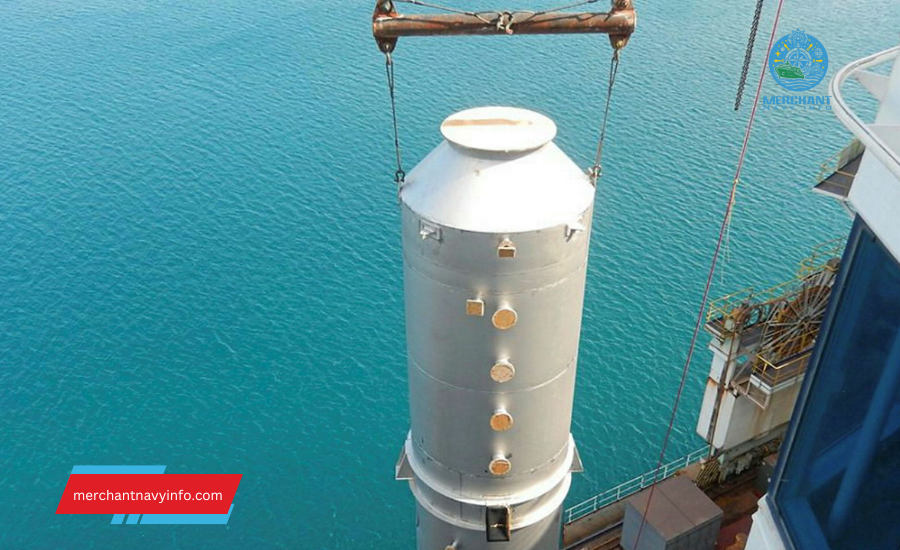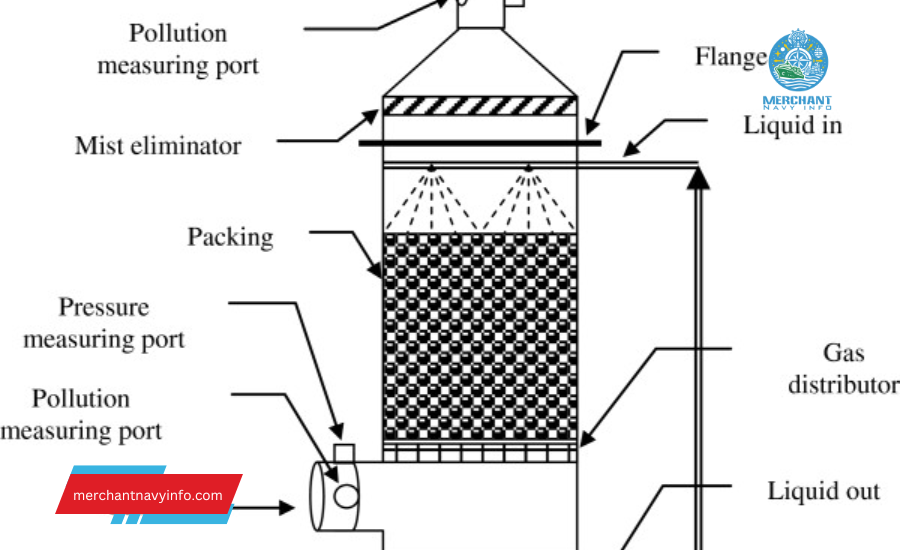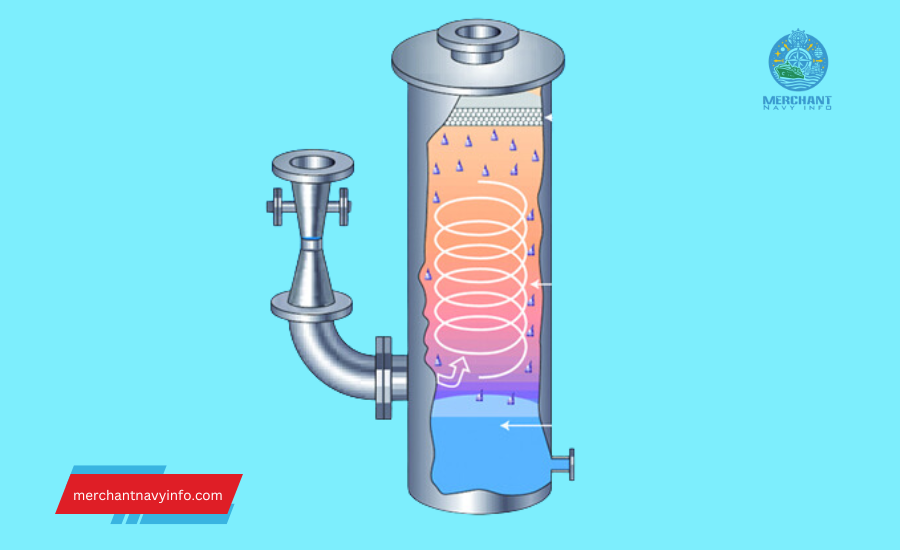
Scrubber Towers: Key to Cleaner Emissions in the Shipping Industry
The shipping industry, a vital cog in the global economy, has long been associated with a less desirable distinction: it significantly contributes to air pollution. Massive cargo ships traversing the world’s oceans burn colossal fuel, releasing harmful emissions into the atmosphere. However, technological innovation is emerging as a beacon of hope, promising cleaner air and a more sustainable future for maritime transport: scrubber towers.
What is Scrubber Towers?
Imagine a colossal air purifier, custom-built to withstand the harsh conditions of the open ocean, tirelessly working to cleanse the exhaust fumes billowing from massive cargo ships. This is the essence of a scrubber tower, a towering technological marvel designed to capture and neutralize harmful pollutants before they can escape into the atmosphere. Picture a huge showerhead, drenching the exhaust with a cleansing spray. And you begin to grasp the mechanics of this innovative solution.
A diverse array of scrubber tower types has emerged, each employing a unique approach to exhaust purification.
Open-loop scrubbers:
The most prevalent type of open-loop scrubber harnesses readily available seawater to ‘scrub’ the exhaust gases. The seawater, acting as a natural sponge, absorbs the pollutants, allowing the cleansed exhaust to be safely released into the atmosphere. However, this process generates ‘dirty’ seawater. Which is subsequently treated and discharged into the ocean, raising legitimate concerns about its potential impact on the marine environment.
Closed-loop scrubbers:
Closed-loop scrubbers, in contrast, operate on a principle of recycling and conservation. They employ a circulating solution of freshwater and chemicals to purify the exhaust. The pollutants are effectively trapped within this solution, which is then treated and reused, significantly minimizing the environmental footprint.
Hybrid scrubbers:
Hybrid scrubbers, as their name implies, represent a fusion of open-loop and closed-loop systems. This ingenious combination grants them the flexibility to switch between modes of operation, adapting to the specific requirements of the operating environment and prevailing regulatory standards.
The evolution of scrubber towers showcases the shipping industry’s commitment to environmental responsibility. By embracing innovative technologies like these, the industry is taking proactive steps to mitigate its impact on the planet. While challenges and concerns persist, scrubber towers’ ongoing development and refinement offer hope, illuminating a path toward a cleaner, more sustainable future for maritime transport.

The Environmental and Economic Advantages of Scrubber Towers
Integrating scrubber towers into the maritime industry heralds many benefits. Extending a lifeline to the shipping sector’s environment and economic well-being.
Drastic Reduction in Sulfur Oxide (SOx) Emissions:
Among these advantages is the dramatic reduction in sulfur oxide (SOx) emissions. SOx, a notorious air pollutant infamous for its contribution to acid rain and a host of respiratory ailments, is significantly curbed by the implementation of scrubber towers. These sophisticated systems can remove up to 98% of SOx from ship exhaust, signifying a monumental leap forward in mitigating the industry’s adverse ecological impact.
Seamless Compliance with Stringent Regulations:
Furthermore, scrubber towers are key enablers for seamless compliance with stringent international regulations. The International Maritime Organization (IMO) recognizes the urgent need to address maritime pollution. It has enacted rigorous limits on sulfur emissions from ships. Scrubber towers empower shipowners to effortlessly meet these regulations without resorting to the financially taxing alternative of switching to pricier low-sulfur fuels.
Potential for Curbing Other Pollutants:
Beyond their primary function of SOx removal, scrubber towers also have the potential to curb other detrimental pollutants. While their core design focuses on sulfur emissions, these systems can also reduce particulate matter (commonly known as soot) and nitrogen oxides (NOx). Which pose significant threats to air quality and human health. This multifaceted capability further underscores the value of scrubber towers in fostering a cleaner and healthier environment.
Cost-Effective Solution:
From an economic standpoint, scrubber towers present themselves as a cost-effective solution. When juxtaposed with the alternative of adopting low-sulfur fuels, which can place a considerable financial strain on shipowners. Scrubber towers emerge as a more economically viable option, particularly when considering the long-term perspective. The savings accrued from avoiding the premium associated with low-sulfur fuels can offset the initial investment in these systems.
Scrubber towers embody a harmonious blend of environmental stewardship and economic pragmatism. They offer a tangible solution to the pressing challenge of maritime pollution. Enabling the shipping industry to navigate a course toward a greener and more sustainable future while safeguarding its financial viability. As the world grapples with the complexities of climate change and environmental degradation, innovations like scrubber towers are a testament to human ingenuity and our collective resolve to protect the planet we call home.

Navigating the Challenges and Considerations
While scrubber towers undoubtedly illuminate a promising path toward a cleaner and greener shipping industry, their implementation is not without complexities and challenges that demand careful consideration and proactive management.
Initial Investment and Operational Expenses:
Foremost among these is the financial hurdle posed by the initial investment and operational expenses. Installing a scrubber tower is not trivial; it necessitates a substantial upfront capital outlay.
Moreover, the financial commitment extends beyond the initial installation, as recurring costs are associated with maintenance and operation. In the case of open-loop systems, wastewater treatment. These ongoing expenses must be factored into the overall economic equation when evaluating the viability of scrubber tower adoption.
Space Constraints:
Another challenge lies in the spatial constraints inherent to shipboard installations. Scrubber towers, by nature, can occupy a considerable footprint on a vessel. This can present a logistical difficulty for smaller ships or those with limited deck space, necessitating meticulous planning and integration to ensure that the scrubber system keeps the vessel’s operational functionality and cargo capacity intact.
Environmental Concerns:
Furthermore, despite their significant contribution to reducing air pollution, scrubber towers are not immune to environmental concerns. While they effectively curtail emissions into the atmosphere, the discharge of wash water from open-loop systems into the marine environment has raised valid concerns. The acidity and chemical content of this wash water can potentially impact marine life and disrupt the delicate ecological balance of the oceans. This necessitates the implementation of responsible management practices. Including the treatment and monitoring of washwater discharge to mitigate any adverse environmental effects.
The Imperative of Proper Maintenance and Monitoring:
Finally, the imperative of proper maintenance and monitoring must be balanced. To ensure that scrubber towers consistently deliver optimal performance and remain in compliance with stringent environmental regulations, they require regular maintenance and vigilant oversight of their operation. This proactive approach guarantees that these systems function as intended, maximizing their pollution-reducing potential and upholding the industry’s commitment to environmental stewardship.

The Horizon for Scrubber Towers: A Beacon of Hope Illuminating a Sustainable Future
Despite the complexities and challenges accompanying their implementation, scrubber towers’ future is promising. The shipping industry steadily embraces this innovative technology, propelled by various factors. Including increasingly stringent environmental regulations and a burgeoning awareness of the urgent need for sustainable practices.
Additionally, this growing adoption signifies a paradigm shift within the maritime sector, a recognition that environmental responsibility is compatible with and essential to long-term economic viability.
Technological advancements are serving as a powerful catalyst in this transformative journey. Continuous research and development efforts are relentlessly refining scrubber systems. Making them more efficient in their pollution-reducing capabilities and more compact and environmentally friendly.
However, this relentless pursuit of innovation is gradually eroding the barriers to adoption, making scrubber towers an increasingly attractive and accessible solution for a wider range of vessels.
As the world charts a course toward a greener and more sustainable future. Scrubber towers are poised to play a pivotal role in decarbonizing the shipping industry and safeguarding the health of our oceans and atmosphere.
Their ability to significantly curtail harmful emissions positions them as a key instrument in the global fight against climate change and environmental degradation. They represent a tangible and impactful step towards a more sustainable maritime sector. Economic growth and environmental responsibility are not seen as opposing forces but as intertwined and mutually reinforcing objectives.
Conclusion:
Scrubber towers may not command the spotlight like flashier and more attention-grabbing technologies, but their contribution to a cleaner and healthier planet is undeniable. These unassuming giants, diligently capturing and neutralizing harmful emissions, are quietly paving the way for a future where the shipping industry operates in harmony with the natural world.
As the maritime world continues its voyage towards sustainability, scrubber towers stand tall as a testament to human ingenuity, innovation, and our unwavering commitment to preserving the delicate balance of our planet for generations to come. Their presence on the high seas serves as a beacon of hope, illuminating a path toward a future where economic prosperity and environmental stewardship coexist in perfect equilibrium.









